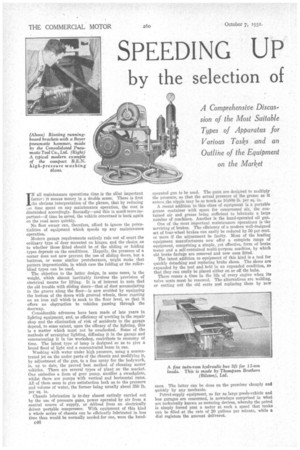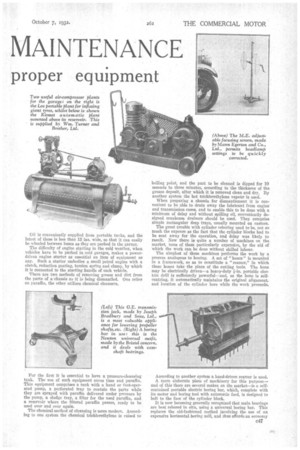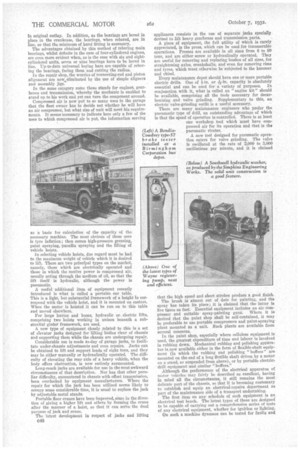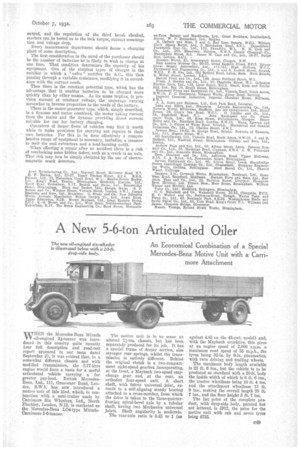SPEEDING UP
Page 96

Page 97

Page 98

Page 99

If you've noticed an error in this article please click here to report it so we can fix it.
by the selection of
MAINTENANCE r
proper equipment
IN all maintenance operations time is the mi5st important factor: it means money in a double sense. There is first the obvious interpretation of the phrase, that by reducing ,..te time spent on any maintenance operation, the cost is diminished accordingly. Secondly—and this is much more important—if time be saved, the vehicle concerned is back again on the road more quickly.
No fleet owner can, therefore, afford to ignore the potentialities of equipment which speeds up any maintenance operation.
Modern garage requirements entirely rule out of court the ordinary type of door mounted on hinges, and the choice as to whether those fitted should be of the sliding or folding types depends on the conditions. Happily, the presence of a corner does not now prevent the use of sliding 'doors, but a buttress, or some similar protuberance, might make that pattern impracticable, in which case the folding or the rollerblind types can be used.
The objection to the latter design, in some cases, is the weight, which almost inevitably involves the provision of electrical means for lifting. It is of interest to note that the old trouble with sliding doors—that of dust accumulating in the groove along the floor—is now avoided by equipping the bottom of the doors with grooved wheels, these running on an iron rail which is sunk to the floor level, so that it offers no obstruction to vehicles passing through the doorway.
Considerable advances have been made of late years in lighting equipment, and, as efficiency of working in the repair shop and the elimination of risk of accidents in the garage depend, to some extent, upon the efficacy of the lighting, this is a matter which must not be overlooked. Some of the methods of arranging lighting, diffusing it in the garage and concentrating it in tee workshop, contribute to economy of time. The latest type of lamp is designed so as to give a broad flood of light and a concentrated beam in one.
Washing with water under high pressure, using a concentrated jet on the under parts of the chassis and modifying it, by adjustment of the gun, to a fine spray for the bodywork, is, up to date, the proved best method of cleaning motor vehicles. There are several types of plant on the market. One embodies a form of gear pump, anotfier a swashplate, whilst there are pumps with vertical and horizontal rams. All of them seem to give satisfaction both as to the pressure and volume of water, the former being usually about 350 lb. per sq. in.
Chassis lubrication is to-day almost entirely carried out by the use of pressure guns, power operated by air from a .central source of supply, or detived from an electrically driven portable compressor. With equipment of this kind a whole series of chassis can be efficiently lubricated in less time than would be normally needed for one, were the hand
c46 operated gun to be used. The guns are designed to multiply the pressure, so that the actual pressure of the grease as it enters the nipple may be so much as 10,000 lb. per sq. in.
A recent addition to this class of equipment is a portable grease container with space for compressed air, the contained air and grease being sufficient to lubricate a large number of machines. Another is the hand-operated oil gun.
One of the most important maintenance operations is the servicing of brakes. The efficiency of a modern well-designed set of four-wheel brakes can easily be reduced by 50 per cent. or more if the adjustment be faulty. Most of the leading equipment manufacturers now offer a complete range of equipment, comprising a simple, yet effective, form of brake tester and a self-contained multi-purpose machine, by which old brake facings are removed and new ones fitted. The latest addition to equipment of this kind is a tool for quickly detaching and replacing brake shoes. The shoes are expanded by the tool and held in an expanded condition, so that they can easily be placed either on or off the hubs.
There comes a time in the life of every engine when its valve seats must be renewed. The alternatives are welding, or cutting out the old seats and replacing them by neW ones. The latter can be done on the premises cheaply and quickly by any mechanic. Petrol-supply equipment, so far as large gooh-vehicle and bus garages are concerned, is nowadays comprised in what are technically known as meteriug devices, whereby the petrol is simply forced past a meter at such a speed that tanks can be filled at the rate of 20 gallons per minute, while a dial registers the amount delivered.
Oil is conveniently supplied from portable tanks, and the latest of these is less than 13 ins, wide, so that it can easily be wheeled between buses as they are parked in the garage.
The difficulty of engine starting in the cold weather, when vehicles have to be parked in cold garages, makes a powerdriven engine starter as essential an item of equipment as any. Such a starter embodies a small petrol engine with a clutch, reduction gearing, torsion spring and clamp, by which it is connected to the starting handle of each vehicle.
There are two methods of removing grease and dirt from the parts of a chassis as it is being dismantled. One relies on paraffin, the other utilizes chemical cleansers.
For the first it is essential to have a pressure-cleansing tank. The use of such equipment saves time and paraffin. This equipment comprises a tank with a hand or foot-operated pump, a perforated tray to contain the parts while they are sprayed with paraffin delivered under pressure by the pump, a sludge tray, a filter for the used paraffin, and a reservoir where the filtered paraffin passes, ready to be used over and over again.
The chemical method of cleansing is more modern. According to one system the chemical triehlorethylene is raised to boiling point, and the part to be cleaned is dipped for 10 seconds to three minutes, according to the thickness of the grease deposit, after which it is removed clean and dry. By another system the hot trichlorethylene vapofir is used.
When preparing a chassis for dismantlement it is convenient to be able to drain away the lubricant from engine and transmission cases, and to enable this to be done with a minimum of delay and without spilling oil, conveniently designed crankcase drainers should be used. They comprise simple rectangular deep trays, usually mounted on castors.
The great trouble with cylinder reboring used to be, not so much the expense as the fact that the cylinder blocks had to be sent away for the operation, and delay was likely to result. Now there is quite a number of machines on the market, none of them particularly expensive, by the aid of which the work can be done without skilled labour.
The simplest of these machines performs the work by a process analogous to honing. A set of "hones" is mounted in a framework, so as to constitute a "reamer," in which these hones take the place of the cutting tools. The hone may be electrically driven—a heavy-duty t-in. portable electric drill is sufficiently powerful—and, as the hone is self. mitring, it automatically maintains the original alignment. and location of the cylinder bore while the work proceeds.
According to another system a hand-driven reamer is used.
A more elaborate piece of machinery for this purpose— and of this there are several makes on the market—is a selfcontained portable electric boring bar, which, complete with its motor and boring tool with automatic feed, is designed to bolt to the face of the cylinder block.
It is now becoming generally recognized that main bearings are best rebored in situ, using a universal boring bar. This replaces the old-fashioned method involving the use of an expensive horizontal, boringmill, and thus affords an economy in original outlay. In addition, as the bearings are bored in place in the crankcase, the bearings, when rebored, are in line, so that the minimum of hand fitting is necessary.
The advantages obtained by this method of reboring main bearings, whilst definite in the case of four-cylindered engines, are even more evident when, as is the case with six and eightcylindered units, seven or nine bearings have to be bored in line. Up-to-date universal boring bars are capable of reboring the bearings, facing them and cutting the radius.
In the repair shop, the worries of Connecting-rod and piston alignment are now4eliminated by the use of simple aligners and assembly jigs.
In the same category come those stands for engines, gearboxes and transmission, whereby the mechanic is enabled to stand up to his work and yet can turn the component around.
Compressed air is now put to so many uses in the garage that the fleet owner has to decide not whether he will have an air compressor, but what size of unit will meet his requirements. It seems necessary to indicate here only a few of the uses to which compressed air is put, the information serving as a basis for calculation of the capacity of the necessary machine. The most obvious of these uses is tyre inflation ; then comes high-pressure greasing, paint spraying, paraffin spraying and the lifting of vehicle hoists.
In selecting vehicle hoists, due regard must be had. to the maximum weight of vehicle which it is desired to lift. There are two principal types on the market, namely, those which are electrically operated and those in which the motive power is compressed air, usually acting through the medium of oil, so that the lift itself is hydraulic, although the power is pneumatic.
A useful additional item of equipment recently introduced is what is called a portable car table. This is a light, but substantial framework of a height to correspond with the vehicle hoist, and it is mounted on castors. When the motor is hoisted it can be run on to this table and moved elsewhere.
For large lorries and buses, hydraulic or electric lifts, comprising two hoists working in unison beneath a substantial girder framework, are used.
A new type of equipment closely related to this is a set of elevator jacks designed for lifting bodies clear of chassis and supporting them while the chassis are undergoing repair.
Considerable use is made to-day of garage jacks, to facilitate under-chassis adjustments and even repairs. Jacks can be obtained to lift and support loads of eight tons, and they may be either manually or hydraulically operated. The-difficulty of elevating the rear axle of a heavy vehicle( when the body offers obstruction, is now entirely surmounted.
Long-reach jacks are available for use in the most awkward circumstances of that description. Nor has that other peculiar difficulty, encountered in chassis with offset transmission, been overlooked by equipment manufacturers. Where the repair for which the jack has been utilized seems likely to occupy some considerable time, it is usual to replace the jack by adjustable metal stands.
Portable floor cranes have been improved, some in the direction of giving a higher lift and others by forming the crane after the manner of a hoist, so that it can serve the dual purpose of jack and crane.
The latest development in respect of jacks and lifting C48 appliances consists in the use of separate jacks specially devised to lift heavy gearboxes and transmission parts.
A piece of equipment, the full utility of which is rarely appreciated, is the press, which can be used for innumerable operations. Presses are available in all sizes from 8 to 80 tons, and are either screw or hydraulically operated. They are useful for removing and replacing bushes of all sizes, for straightening axles, crankshafts, and even for removing rims and tyres, which must otherwise be subjected to the hammer and chisel.
Every maintenance depot should have one or more portable
electric drills. One of or -[5,5-in. capacity is absolutely essential and can be used for a variety of purposes. In conjunction with it, what is called an 'engine kit" should be available, comprising all the tools necessary for decarbonizing and valve grinding. Supplementary to this, an electric valve-grinding outfit is a useful accessory.
There are many maintenance engineers who prefer the pneumatic type of drill, an outstanding advantage of which
is that the speed of operation is controlled. There is at least one workshop tool which must have compressed air for its operation and that is the pneumatic riveter.
A new tool designed for pneumatic operation caters for valve grinding. The valve is oscillated at the rate of 2,000 to 3,000 oscillations per minute, and it is claimed that the high speed and short strokes produce a good finish. The brush is almost out of date for painting, and the spray has taken its place; it is claimed that the latter is five times as fast. Essential equipment includes an air compressor and suitable spray-painting guns. Where it is desired that the paint shop shall be self-contained, it may be preferable to use portable compressors and paint-spraying plant mounted as a unit. Such plants are available from several concerns. In the paint shop, especially where cellulose equipment is used, the greatest expenditure of time and labour is involved in rubbing down. Mechanical rubbing and polishing apparatus isnow available either in the form of flexible-shaft equipment (in which the rubbing and polishing "buffers" are mounted on the end of a long flexible shaft driven by a motor on a stand, or suspended from above), or by portable electricdrill equipment and similar "buffers." Although the performance of the electrical apparatus of motor vehicles may fairly be described as excellent, having in mind all the circumstances, it still remains the most delicate part of the chassis, so that if is becoming customary to establish and equip an electrical-repairs department as part of the maintenance side of a transport undertaking. The first item on any schedule of such equipment is an electrical test bench. The latest types of these are designed to be capable of carrying out a comprehensive series of tests of any electrical equipment, whether for ignition or lighting.
On such a machine dynamos can be tested for faults and
output, and the regulation of the third brash checked, starters can be tested as to the lock torque, current consumption and voltage drop, Every maintenance department should house a charging plant of some description, The first consideration in the mind of the purchaser should be the number of batteries' he is likely to wish to charge at one time. That condition determines the capacity of his equipment. One of the simplest types Of charger is the rectifier in which a " valve " rectifies the AC., this then passing through a variable resistance, modifying it in accordance with the current needs.
Then there is the constant potential type, which has the advantage thatit enables batteries to be charged more quickly than by other means. As its name implies, it provides current at constant voltage, the amperage varying somewhat in inverse proportion to the needs of the battery,
There is the motor-generator type, which, simply described, is a dynamo and motor combined, the motor taking current from the mains and the dynamo providing direct current suitable for use for battery charging.
Operators of larger fleets of vehicles may find it worth. while to make provision for carrying out repairs to their Own batteries. For this to be done effectively a comprehensive range of equipment is necessary, including a steamer to melt the seal extractors and a lead-burning outfit.
When effecti.ng a repair after an accident there is a risk of overlooking some hidden defect, such as a crack in an axle, That risk may now he simply obviated by the use of electromagnetic crack detectors.
Arced Manufacturing Co., _Ltd.,• Digswell Street, Holloway Road, N.7, B. P. Berms, Ltd., 33-37, Upper Thames Street, EC.4.
Patents, Ltd., 92, Tottenham Court Road, W.1.. Bendix-Petrot Brakes. Ltd., King's Road, Tyseley, Birmingham. Benjamin Electric, Ltd., Tariff Road Tottenham, N.17. Benton and Stone, Ltd., Bracebridge Street, Birmingham. Black and Decker, Ltd., Slough, Bucks. S. F. Bowser and (to., Windsor House, Viotoria Street, London, S.W.1. Joseph Meal:airy and Sons, Ltd., Braintree. 0. Brady and Co., New Islington Works, Annals, Manchester. British Oxygen Co., Ltd., Angel Road, Upper Edmonton, N.18. Brown Brothers, Ltd., Great Eastern Street, E.C.3 E. G. Brown and Co., Ltd., West Road, Northumberland Park, Tottenham, N.17. The Bosnia Engineering Co., Boyd Street, Newoastle
on-myne. Burney and Blaokburne, Ltd., Great Beckham, Leatherhead, Surrey. W. P. Butterfield, Ltd., Shipley.
R. Cadisch and Sons, 5 and 6, Red Lion Square, W.0.1, William Clark (Spare Parts), Ltd., 5 Marshalsea Road, 8.E.1. Consolidated Pneumatic Tool Co., Ltd., 170, Piccadiny, W.1, R. H. Cook and Co., Ltd_, 209, Broadway, Hendon, N.W.9, County Chemicialt.C.0., Thanderford Street, Ed. James W. Carr and Co., Ltd., 26-27, Budge Row, Landon, BAIL • Durable Works, 81, Avenuepark Street, Glasgow, N.W. East London Rubber Co., 29-33, Great Easlorn Street, E.0.3. Educa• Clonal Supply Association, Ltd., 171-181, High Holborn, W.C.1. Equipment and Engineering Co., Ltd., 2 and 3, Norfolk Street., Strand, W.C.2. F. H. Eve, Ltd., Old Radford Road, Luton, Beds. Kurt Erlach,, 2, Mellor Street, London, S.E.1. Harvey Frost and Co., Ltd., 148, Great Portland Street, W.A.
Fredk. J. Gordon and Co., Ltd., 92, Charlotte Street, W.1. Grimston Electric Tools, Ltd., 138, Lever Street, 5.0.2. Guest, Keen and Nettlefold, Ltd., Box 24, Heath Street, Birmingham.
Hammond Pump and Equipment Co., Ltd., Victoria Road, North Acton, N.W.10, P. C. Henderson, Tangent Works, Abbey Road, Barking. Imperial Chemical Industries, Imperial Chemical House, Millbank, S.W.1.
A. A. Jones and Shipman, Ltd., East Park Road, Leicester. Lake and Elliot, Lt.cl., Braintree. Layeock Engineering C.o., Ltd., Victoria Works; Millhouses, Sheffield. Leo Air Compressors, Ltd. Shield House, 28, Gray's Inn Road, W.0.1. O. Lindley and Oa., Ltd., 34, Englafield Road, Ni. John Macdonald and 0. (Pneu matic Tools, Ltd., 43, King Street, rollockshaws, Glasgow. Henry Miller and Co., Standard Road, London, N.W.10. Mann, Egerton and Co., Ltd., 5, Prince of Wales Road, Norwich. Mechanical and General Inventions Co., Ltd., 10, Charles Street, &W.1. Newton Bros., 24-32, St, George Road, Bristol. Newtons ol Taunton, Ltd., 319, Regent Street, W.1.
Oil Installations, Ltd., Victoria Road, North Acton, N.W.10. J. and R. Oldfield, Ltd., Warwick Street, Birmingham. Oldham and Sons, Ltd., Denton.
Andrew Page and Son. Ltd., 99, Albion Street, Leeds. Parsons NonSkid Co., Ltd., 35, Macaulay Road, Clapham, S.W.4. J. W, Pickavant and CA., Ltd., Granville Street, Birmingham. Ross, Courtney and Co., Ltd., Ashbrook Road, Tipper Hollaway, N.19. J. A. Ryley, 3-5, Newmarket Street, Birmingham. Service Equipment Co., Ltd., 99, Albion Street, Leeds. Sheepbridge Stokes Centrifugal Castings Co., Ltd., Chesterfield. Simpkins Engineering Works, Gedling, Nottingham., Steel Barrel Co., Ltd., Phmnix Wharf, Uxbridge.
Tangyes, Ltd., Cornwall Works, Birmingham. Tecalemit, Ltd. Great . West Road, Brantford, Middlesex. Herbert Tarry and Sons, Ltd., Redditch. Theo and Co., Ltd., 32, Tarleton Street, Liverpool, Thompson Bros. (Bilston), Ltd. Timson Bros., Moor Street, Birmingham. William Turner and Brother, Ltd.
Valor Co. Ltd., Bratitford, Erdington, Birmingham.
a C. Wakefield and Co.. Wakefield House, 30-32, Cheapside, E_C.2. -E. C. Walton and Co., Sutton-on-Trent, Newark, Wayne Tank and Pump Co., Ltd., 42, Newlands Park, 5.1126. Westinghouse Brake and. Saxhy Signal Co., Ltd., 82, York Road, King's Cross, Ni, Williams and James, Chequers Bridge, Gloucester.
Messrs. Youngs, Ryland Street Works, Birmingham.




































































































































































